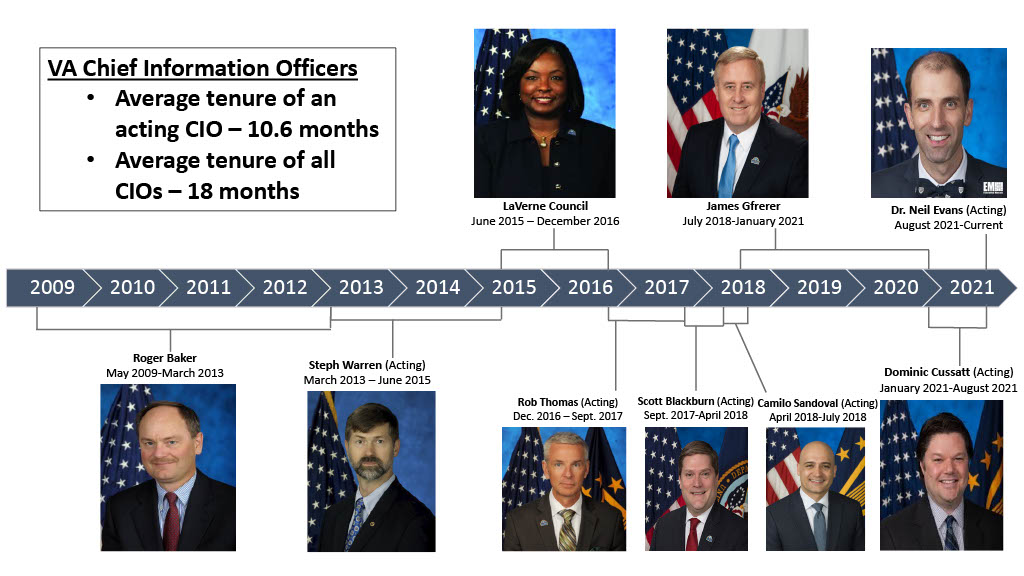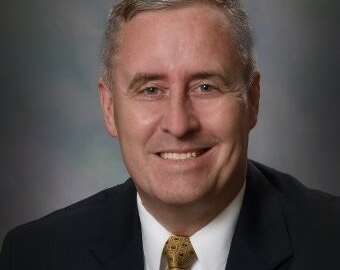VA has had more acting CIOs than permanent ones since 2009
Dr. Neil Evans recently became the second acting chief information officer at the Department of Veterans Affairs in 2021 and sixth in the last 11 years.
Since 2009, the Department of Veterans Affairs has had more acting chief information officers than permanent ones. And the House Veterans Affairs Subcommittee on IT Modernization is worried about all of this turnover.
After the Senate confirmed Roger Baker in 2009 to be the assistant secretary in the Office of Information and Technology and CIO, VA has had only two other permanent CIOs: LaVerne Council and James Grfrerer. The average tenure of an acting CIO is more than 10 months, including one who lasted almost two years, according to the committee’s research.
Dr. Neil Evans, the chief officer for Connected Care and who is performing the delegable duties of the assistant secretary for information and technology and CIO, became the sixth acting technology leader since 2009 at the end of August.
Rep. Matt Rosendale (R-Mont.), ranking member of the Subcommittee on IT Modernization, said this is one of the main reasons why VA continually struggles with major IT projects.
“VA cannot afford to stand still. Operating under an acting chief information officer is no excuse to tread water,” Rosendale said. “Information technology has nothing to do with ideology or party. It is about results. In the VA’s case, it is about continually improving the quality and accessibility of care and benefits for our veterans. I know government bureaucracies tend to value titles and they resist change. Senate confirmation confers authority. However, it would be unacceptable to merely keep the seat warm until the administration puts forward a nominee and the Senate gets around to acting on it.”

It’s unclear where the Biden administration stands on its plans to nominate a permanent assistant secretary and CIO.
It took the Trump administration about 19 months to nominate Grfrerer, and it took the Obama administration more than two years to nominate Council after Baker served about five years as CIO.
It’s not unusual to have acting CIOs, especially at a place like VA where the assistant secretary requires Senate confirmation. But it’s also why Rosendale is so concerned about the impact of having another acting CIO and whether that will slow down critical programs to serve veterans.
Don’t just tread water
Rosendale wants to make sure Evans has the authority, support from the senior leadership and plan to make progress on IT modernization programs.
“The worst thing for OIT to do … would be to tread water until a new assistant secretary is confirmed. So what are your goals? What have you lined out to achieve as the new head of OIT, during the interim?” he asked Evans.
After some back and forth, Evans said he’s focused on improving the digital experience for veterans, ensuring the infrastructure is reliable and modern and delivering services via platforms to ensure they are agile and can be upgraded as needed.
Rosendale’s concerns come on the heels of a successful past few years for VA.
Evans and staff released a mid-year update on IT modernization progress.
“We’ve moved 133 applications to the cloud; we have 82 in progress. There’s roughly 400 in-house-developed apps still floating around out there, but we’ve reduced our custom development from 57% in 2019 to 45% in 2021,” Simpson said during a Sept. 23 press briefing. “We continue to move toward that model, where I think we’re getting that security inheritance through the software-as-a-service products and through the commercial-off-the-shelf (COTS) products and through the cloud.”
VA also upgraded its network infrastructure that has supported more than 12.5 million telehealth appointments over the last 20 months.
“We now have over 95% of our primary care providers, mental health providers and high numbers of our specialists who can deliver care through telehealth. It’s now something that they can do it is something that is part of their therapeutic choices, what they can offer to patients,” Evans said. “I think we’re going to continue to see growth there. We’re going to continue to see growth in inpatient applications of telehealth and engagement of veterans through technologies closer to where they are.”
Hearing scheduled for October
This is exactly the reason why Rosendale and other lawmakers are worried about the decade-long challenge retaining a long-term CIO.
Committee aides, however, did not support the idea of a term appointed CIO as one solution to this problem.
Instead, the committee would like to make sure Secretary Denis McDonough empowers Evans, or whomever the acting CIO is, to do more than tread water on IT modernization.
This issue may come up during the committee’s scheduled hearing in October with VA Deputy Secretary Donald Remy.
VA is one of five cabinet level agencies without a permanent CIO. The White House nominated John Sherman to be the Defense Department’s CIO, but the departments of Treasury, Interior and Health and Human Services remain under acting CIO leadership. Other DoD and VA CIOs need Senate confirmation.
The good news for VA is the OI&T staff bring a wealth of experience and many were former CIOs themselves so they know the challenges of keeping the ship moving forward. Add to that Evans experience as chief of Connected Care and a practicing physician, it seems clear that VA’s technology leadership understands the pain that slowing down IT modernization efforts would cause.
Rosendale and other lawmakers just want assurances that McDonough and Remy understand the issue in the same way.
Copyright © 2025 Federal News Network. All rights reserved. This website is not intended for users located within the European Economic Area.
Jason Miller is executive editor of Federal News Network and directs news coverage on the people, policy and programs of the federal government.
Follow @jmillerWFED






